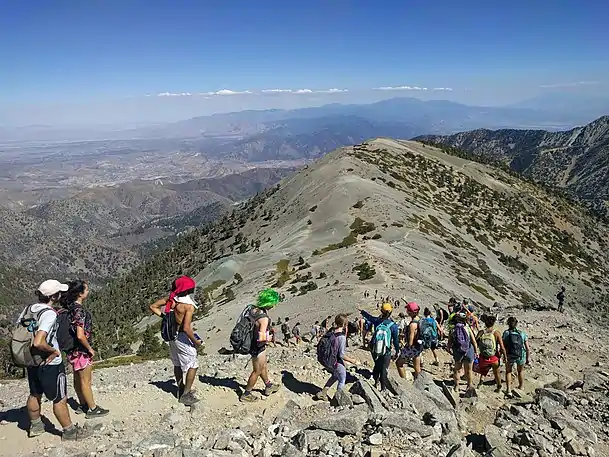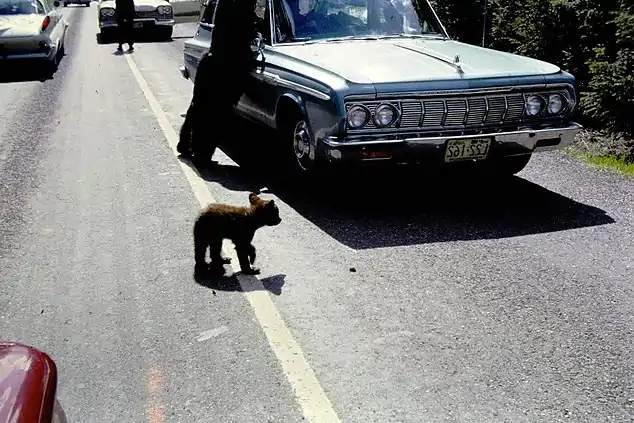Recreation ecology
Recreation ecology is the scientific study of environmental impacts resulting from recreational activity in protected natural areas. This field of study includes research and monitoring assessments of biophysical changes, analyses to identify causal and influential factors or support carrying capacity planning and management, and investigations of the efficacy of educational, regulatory, and site management actions designed to minimize recreation impacts. These ecological understandings of environmental impacts of outdoor recreation is critical to the management of recreation, ecotourism and visitation to natural spaces.[1] Recreation ecology research has looked at the ecological impacts of hiking, camping and other outdoor recreation activities where the use and visitation is concentrated.[2] As outdoor recreation shows increasing participation globally, questions and concerns are raised to which these can be managed sustainably with minimal impact to the environment.[2]

History
While scientific studies of human trampling can be traced back to the late 1920s, a substantial body of recreation ecology literature did not accumulate until the 1970s when visitation to the outdoors soared, threatening the ecology of natural and semi-natural areas.
Recreation ecology as a field of study more officially began in the early 1960s[2] and was addressed in depth by J. Alan Wagar in his work titled The Carrying Capacity of Wild Lands For Recreation[3], published in 1964 in the Society of American Foresters. In this publication, Wagar poses the question: do wild lands have carrying capacities for recreation use? Wagar addresses this question in terms of: (1) impacts of outdoor recreation on people (2) impacts of people in these outdoor spaces and (3) management procedures to address issues of overcrowding in wild lands for recreation.[3]
In the past few decades, more than 1000 articles on recreation ecology have been published.[2] As it is projected that the amount of time spent and the numbers of participants in winter, water based and developed land activities will grow faster than the population,[4] there is a growing importance and need for recreation ecology.
Research
Resource elements examined include soil, vegetation, water, and more recently, wildlife and microbes, with the majority of investigations conducted on trails, recreation sites, and campsites. Use-impact relationships, environmental resistance and resilience, management effectiveness, monitoring techniques, and carrying capacity are some of the major themes in recreation ecology. The impact of trampling from foot, bike, horse, or any other means of traffic in natural spaces is the most common and systematically researched topics in the field of recreation ecology.[2] Additional ecological impacts often studied in the field of recreation ecology include:
- herbaceous plant cover[5]
- vegetation and tree disturbance [2]
- trampling of vegetation[2]
- disturbances to aquatic systems [2]
- disturbances to wildlife[2]
- Soil loss[2]
Trampling of vegetation
The impact of trampling from foot, bike, horse, or any other means of traffic in natural spaces is the most common and systematically researched topics in the field of recreation ecology.[2] Trampling of vegetation is studied often in terms of soil loss, plant loss and erosion.
Aquatic Systems
There are many recreational activities on aquatic systems that have been examined such as recreational power boating, water skiing and swimming.[2] These activities can cause physical disturbances to aquatic habitat through sound and movement, as well as subject these systems to an influx of nutrients, introduction of pathogens and sedimentation.[2]
Wildlife Disturbances
Outdoor recreation has many impacts on wildlife such as wildlife disturbances and habitat destruction. Hiking and camping may affect wildlife habitats through trampling and destruction of wildlife habitats.[6] Additionally hiking and camping can result in noise disturbances for wildlife, as well as produce negative impacts through discarded food and trash.[6] Poor trash management in protected natural areas with high levels of tourism can
Applications and Management
Studying the intensity and extent of these factors can measure the intensity of impacts of outdoor recreation on the environment including the amount of use, type and behavior of use, timing of use, and type and condition of the environment.[2]

Study results have been applied to inform site and visitor management decisions and to provide scientific input to management planning frameworks such as:
- Limits of Acceptable Change (LAC)
- Visitor Experience and Resource Protection (VERP)
- Biophysical carrying capacity
- Designation of protected areas
Recreation Ecology Research publications have been disproportionately focused on North American field sites, and global publications are dominated by Anglophone authors, resulting in these publications being limited to English Scientific journals.[1] Second and third to North America, Europe and Australia have received attention and have had studies conducted on recreation ecology.[2]
Ecotourism
Recent growth of ecotourism has prompted a new batch of recreation ecology studies focusing on developing countries where ecotourism is aggressively promoted. There is an increasing concern that ecotourism is not inherently sustainable and, if unchecked, would generate substantial impacts to ecotourism destinations which are often fragile ecosystems.
Recreation ecology and ecotourism are connected through the Tourism carrying capacity and Biophysical carrying capacity. Understanding the dynamics of nature and resiliency of an ecosystem can allow for the estimate maximum number of visitors can come to a natural space before starting to see negative impacts.
References
- Buckley, Ralf (January 2005). "Recreation Ecology Research Effort: An International Comparison". Tourism Recreation Research. 30 (1): 99–101. doi:10.1080/02508281.2005.11081237. ISSN 0250-8281. S2CID 144977079.
- Monz, Christopher A.; Pickering, Catherine M.; Hadwen, Wade L. (2013). "Recent advances in recreation ecology and the implications of different relationships between recreation use and ecological impacts". Frontiers in Ecology and the Environment. 11 (8): 441–446. doi:10.1890/120358. hdl:10072/58605. ISSN 1540-9309. S2CID 31678641.
- Wagar, Alan (1964). "The carrying capacity of wild lands for recreation". Forest Science. 10: 1–24.
- Bowker, J; English, D; Cordell, H (1999). "Projections of outdoor recreation participation to 2050". Oudoor Recreation in American Life: 323–351.
- Buckley, Ralf (2013). "Next steps in recreation ecology". Frontiers in Ecology and the Environment. 11 (8): 399. doi:10.1890/1540-9295-11.8.399. ISSN 1540-9309.
- Boyle, Stephen A.; Samson, Fred B. (1985). "Effects of Nonconsumptive Recreation on Wildlife: A Review". Wildlife Society Bulletin. 13 (2): 110–116. ISSN 0091-7648. JSTOR 3781422.
Further reading
- Liddle, M. (1997) Recreation Ecology: The Ecological Impact of Outdoor Recreation and Ecotourism, London: Chapman & Hall.
- Monz, C.A., Cole, D.N.. Leung, Y.-F., Marion, J.L. (2010) Sustaining Visitor Use in Protected Areas: Future Opportunities in Recreation Ecology Research Based on the USA Experience. In: Environmental Management 45, 3/2010, pp. 551–562.
- Newsome, D., Moore, S.A. and Dowling, R.K. (2001). Natural Area Tourism: Ecology, Impacts, and Management, Clevedon, UK: Channel View Books.